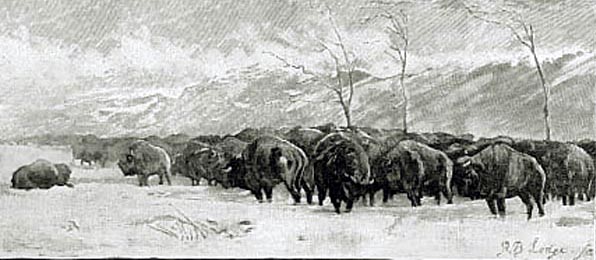
Bison Herd, 1873
Out on the Great Plains stretching from British possessions north of the Medicine Line to the Rio Grande, the bison
moved north in the spring. As explained in The Life and Adventures of Billy Dixon of Adobe Walls, Texas Panhandle
complied by Frederick S. Barde from notes taken by Mrs. Dixon from her husband's memories, Cooperative Publishing Co., Guthrie, Oklahoma, 1914:
North and south across this gigantic stage the teeming animal life of the Plains,
especially the buffaloes moved regularly with the procession of the equinoxes.
The first grass of spring to which the Cheyennes gave the poetic name, mah-nah-see-tah had scarcely made green the
landscape before it was darkened with moving herds northward bound, in obedience to the primal instinct that pulses more deeply with the coming of spring.
Dixon (1850-1913) was orphaned at age 12 and by age 14 was employed as a bullwhacker and muleskinner out on the Plains. At age 20 he became a
buffalo hunter. In 1874, he participated in the Second Battle of Adobe Walls Bat Masterson and some twenty buffalo hunters were beseiged by an estimated 700 to
1000 Indians. He later served as a guide for General Nelson A. Miles, worked as a cowboy for the
Turkey Track ranch in the Texas Panhandle and homesteaded on the site of Adobe Walls.
And in the fall, Dixon continued:
"when Once more the pageant of the wilderness moved on its mysterious way, this time from north to south. The storms of spring and summer had rolled their thunder
through the solitude and reddened the sky with their lightning. The rains had spent themselves. The season of creation and growth had passed. The Plains were shaggy with brown grass."
The bison moved southward. Of this, Dixon noted, "the Indian was lord and master. * * * * The white man had not come, bringing disease and poverty."
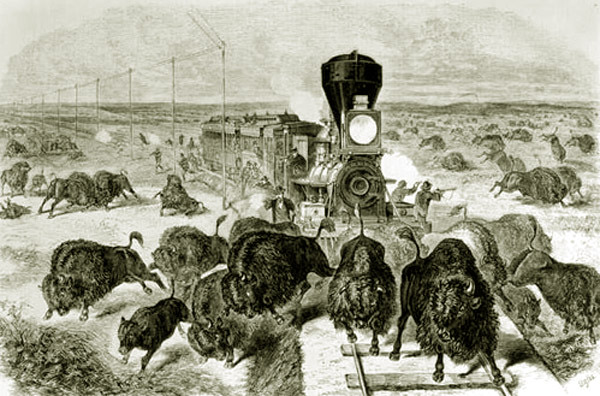
"Slaughter of Buffalo from the Railway," woodcut.
In the 1860's, what was later to become the Kansas-Pacific (the "K-P") began moving westward and by 1867 had reached Salina. To provide food for the railway
workers, the K-P employed a young William F. Cody. As later discussed, his fame as a buffalo hunter later made him a fortune. Congress then authorized and extension to Denver.
In 1870, the link to Denver was completed.
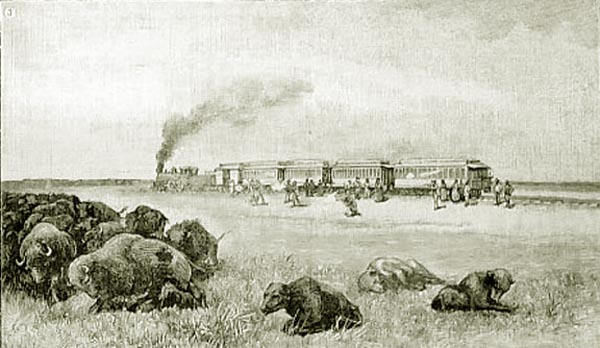
"Slaughter of Buffalo from the Railway," woodcut by Paul Frenzeny, 1873.
Frenzeny (1840-1902) and Jules Tavernier (1844-1889) two French trained artists were employed by
Harper's Weekly to document on a two year trek the American West. In the course of their travels they provided
sketches of buffalo hunting. Little has been documented of Frenzeny's early life. Dispute exists whether he was born in
France or in the Austro-Hungarian Empire. Following his stint with Harper's, he privided illustrations for Kipling's
Jungle Books, and "Humour of France" and "Humour of Russia." He died in London. Most of the illustrations by
Frenzeny of bison hunting on this website are taken from the Illustrated London News and are believed to have been drawn in the area of
Wichita and Dodge City althogh the two ventured as far south as Dennison, Texas, and in Wyoming north to Ft. Laramie and the Red Cloud agency.
Tavernier was born of an English father and
French mother. He first achieved notice as an artist as a war correspondent illustrating the Prussian siege of Paris during the
Franco-Prussian War. His sketches were flown out of Paris by balloon for use in London newspapers.
Following the war, he moved to England and thence to the United States in 1872. He and Frenzeny broke up in an argument in California.
Frenzeny moved back east while Tavernier stayed in California until increasing debt forced him
to move to the Hawaii where he became court artist to King Kalakaua. He spent some time in British Columbia but died in
Hawaii. He is most noted for his paintings of volcanos.
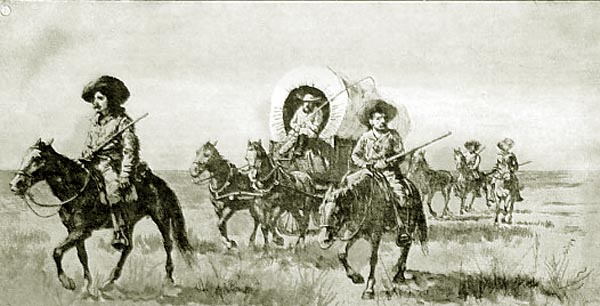
"The Start"
With the coming of the railroad discussed subsequently, the slaughter of the bison by hunters became more efficient. The railroads
could carry the hides to markets in St. Louis. During the Crimean War, the leather used by the
British was primarily made from buffalo hide.
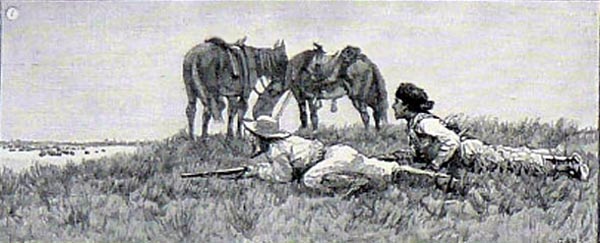
"Creeping up on the Game"
When Dixon started as a buffalo hunter in 1870, The hide of a buffalo bull brought $2.00 and that of a cow $1.00. Two years later, the hide of a bull brought $4.00.
The hunter, who provided the gear and food received 50% of the take, the balance was divided between the skiners and others in party.
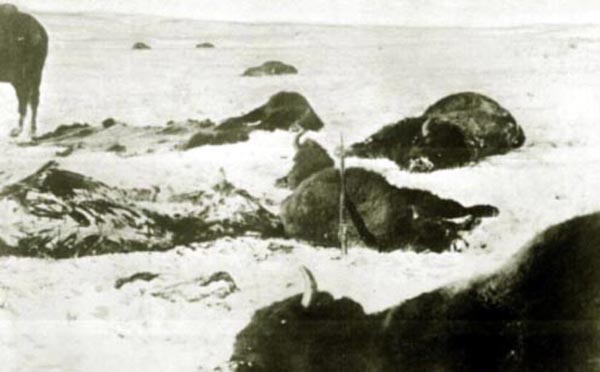
Carcasses of Bison killed by hide hunters, 1872
The skinners would frequently skin
the bison while the carcasses were still warm leaving the skinned bodies for the prairie wolves.
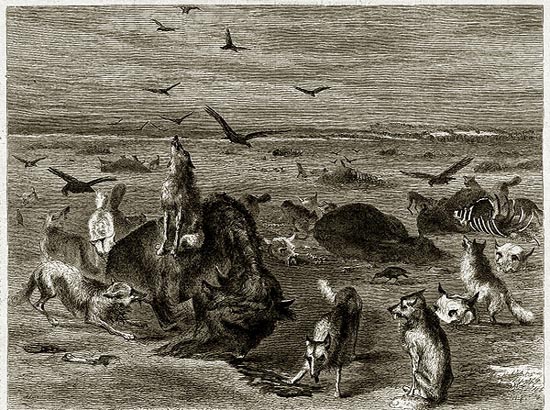
Wolves Devouring Carcasses of Bison, Harper's
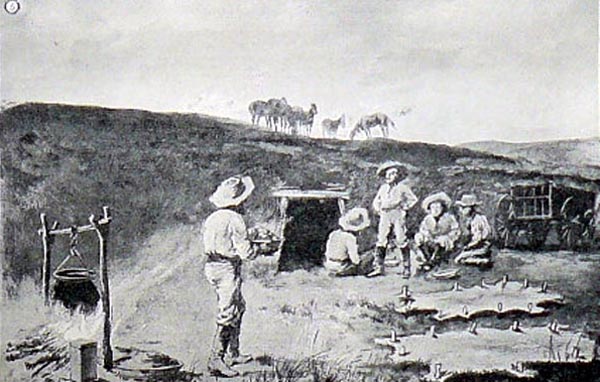
"In Camp"
As illustrated above and in the next sketch, after the animal was skinned the pelts were stretched out on the ground with 6-inch stakes, flesh side up.
Arsenic and other poisons were applied to discourage insects and prairie wolves. The hides would be left for two-days and then
turned every day for five days to dry before being stacked.
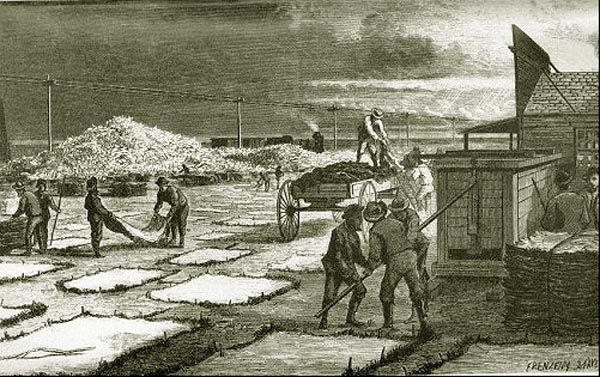
Stretching Buffalo Hides
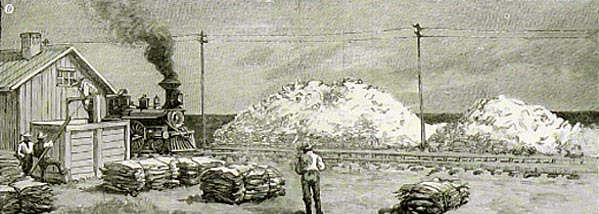
"Bone Heaps and Hides along the Railway"
Others made their living by gathering buffalo bones to be shipped off to make fertilizer. the two principal locations for shipment of the bones and
hides were Wichita and Dodge City.
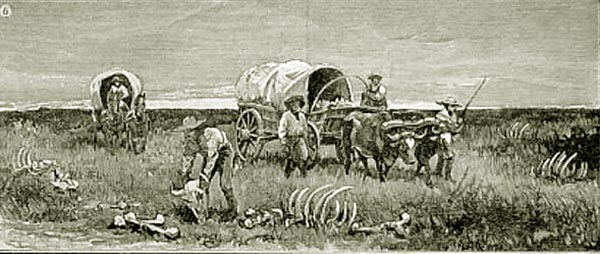
"Bone Hunters"
The slaughter was incredible. In one small town in Texas, Rath City, some 1.1 million
hides were shipped out in a three year period. Rath City, now a ghost town, was founded by
Charles Rath (1836-1902) Rath had gotten his start in 1853 as a freighter hauling goods for William Bent's fort. He soon established mercantile
empire. With the coming of the railroad in Western Kansas his empire expanded into providing supplies for
Buffalo hunters and buying the hides for shipment east. In addition to Rath City, his main center for shipment was
Dodge City. He was in the process of establishing an additional store and restaurant at the time of the Second Battle of Adobe Walls.
Additionally, he was no slouch as a buffalo hunter himself. He set a record killing 107 bison in one hour.
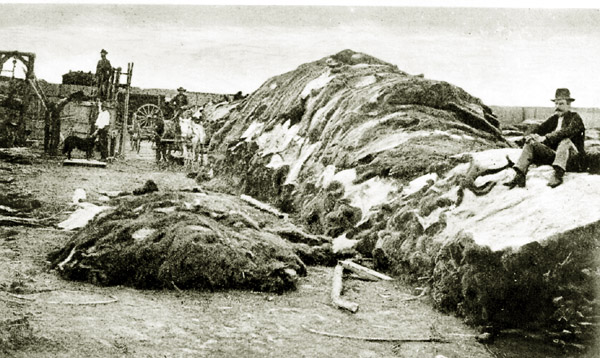
Charles Rath seated on pile of hides, Rath Hide Yard, Dodge City.
Next page: Buffalo Hunters on the northern Great Plains, the effect Buffalo Hunting upon the American Indians.
|